10 Best Business Model Canvas Examples For Your Inspiration
Have you ever listed out all important aspects to consider while launching a product or strategy? You must find that this process quite challenging since one paper is not enough to show all this information as well as the connection between them.
Luckily, there is still an effective way for you to focus on your product’s most strategically important elements, which is Business Model Canvas. Many famous brands around the world have made use of it successfully.
In this post, we will bring about all things you need to know about Business Model Canvas as well as 10 Best Business Model Canvas Examples For Your Inspiration.
Let’s dive in with us!
What is a business model canvas?
Before digging into the best examples of Business Model Canvas around the world, let’s find out how the Business Model Canvas was designed.
Generally speaking, the Business Model Canvas is a summary that tells how the key drivers of a business fit together. It means showing the strategic details necessary to help a business get success within the market.
One important thing is that this summary’s length is within one sheet of paper. Imagine when you include all this down in a document, and it turns into many pages to capture all information. This will make you hard to remember as well as waste time opening pages over pages.
When it comes to the Business Model Canvas, you have a smart and clear way to read and describe any company with any scale ranging from the largest business to just a small one with some staff members.
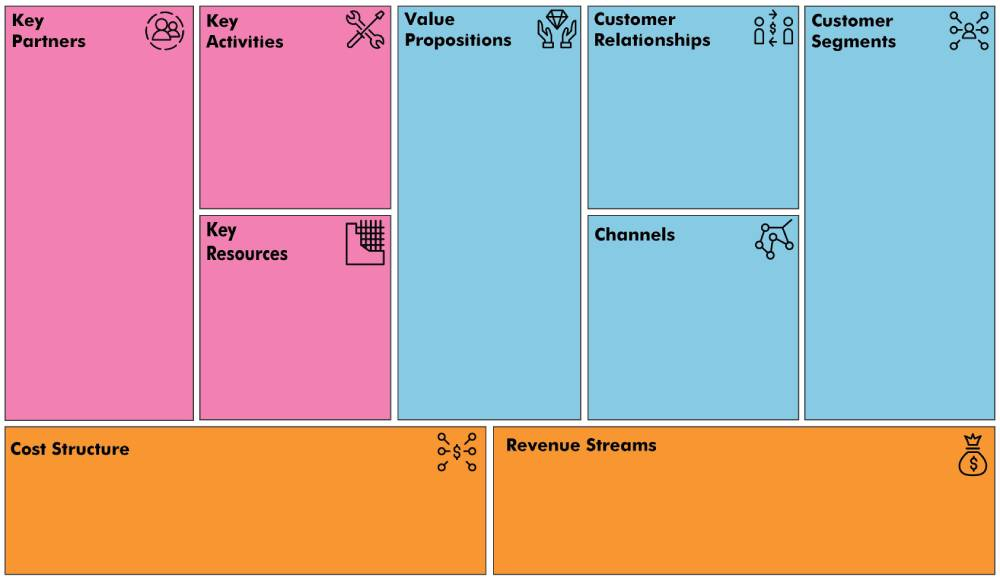
While the categories or buckets included in a canvas can be adjusted according to your wishes, there are nine elements or building blocks that make up the canvas.
Each building block represents each key drivers and segments of a business. To fill in these blocks, you need to answer the following questions:
- Customer segments: Who do you target as customers?
- Value proposition: What are your strengths to make customers buy from your business?
- Channels: Which channels do you use to deliver your products or services to the market?
- Customer relationships: What are your strategies to get, keep, and build up the relationships with your customers?
- Revenue streams: How will you make money?
- Key resources: What are the special strategic resources that you own as well as a need?
- Key activities: What will your business do to deliver your value proposition?
- Key Partnerships: What are the non-key activities that you do to help your company focus more on your key activities?
- Cost structures: What are the biggest costs that your business earns?
There is one thing to note before finding out what these elements detailedly are. That is the connection between the left side and right side of the Business Model Canvas. If you notice, all elements on the left-hand side of the canvas show the business’s costs, while those on the right-hand side represent revenue generated for the business.Along with a business model canvas, it is advisable to have a well-crafted presentation in the form of a pitch deck. These can be created effortlessly using an AI presentation maker.
Now, it’s time to discover the definitions as well as meanings of 9 elements:
Customer segments
The first building block you should look at is Customer Segments. Here is where you will add in all the different customer groups that you will target. Besides naming these customer groups, you can also build one or more personas for each segment your company serves.
If you are confused about the information you should include when it comes to a persona, it is just a detailed description of each customer group you list. They can include what motivates your customers to buy products, what problems they are suffering that you can help, and perhaps the essence of who they are.
Many businesses make a mistake when assuming that customers exist for themselves to serve. In fact, businesses exist to serve their customers instead.
Depending on your business’ goals, you can have one customer segment or more. Many companies target only one customer group, but many serve two or even multiple. For example, the giant SEO company serves two customer segments, which are those performing searches and those working as advertisers.
In case you want to break down the advertiser customer group into many personas, there will be various kinds of advertisers that you can examine.
Value proposition
The second building block refers to Value Proposition. It means the values that your company or your service can bring to each customer segment. Before filling in this building block, question yourself what problems you can solve for each customer segment are as well as what needs you can satisfy. In other words, the value proposition means the reasons why customer segments buy from you but not from others.
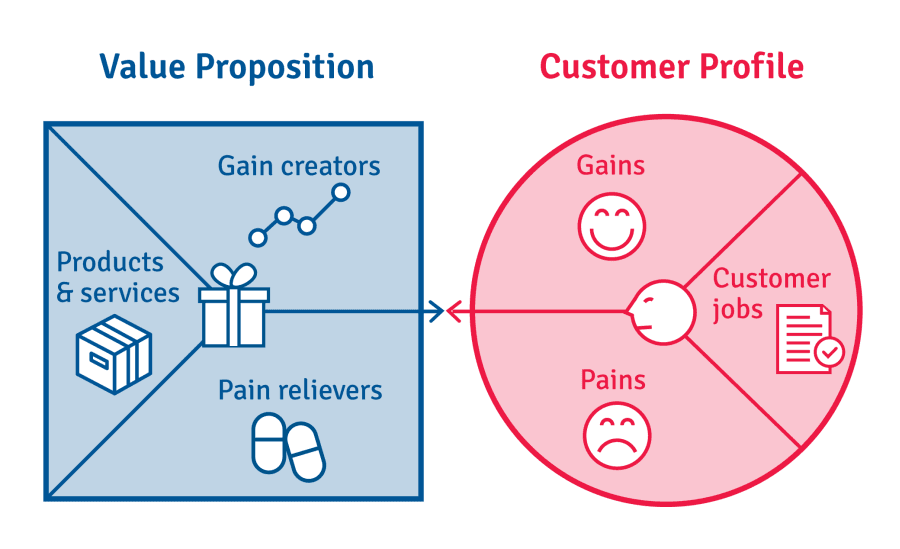
If you still find it difficult to define, here are some of the most common value propositions:
- The performance quality
- Newness
- The ability to customize depending on customers’ wishes
- The designing
- Brand
- Status
- The pricing plans
- The cost reduction
- The risk reduction
- Simplicity
- Convenience
Channels
Next, let’s come to the way your products or services are given to your customers. It is Channels. It is about how you sell your products and how your customers want to be approached. Consider the way your company is reaching them at the moment before adding in the Channels building block.
There are two types of channels that you might concern which are having your own channels and having partner channels with someone else.
When it comes to the first type, having your own channels means a combination of all shops you belong to, all sales staff you are employing, or all your websites.
In terms of having partner channels with someone else, you have a wide range of choices, from using Google Adsense to sell your services to using a wholesaler or even partnering with affiliates to advertise your products. You can promote your product with a blog post, social media mentions, a viral video campaign, an interactive Flipbook maker or a live stream (here is an example of simple streaming software, you could start with).
Customer relationships
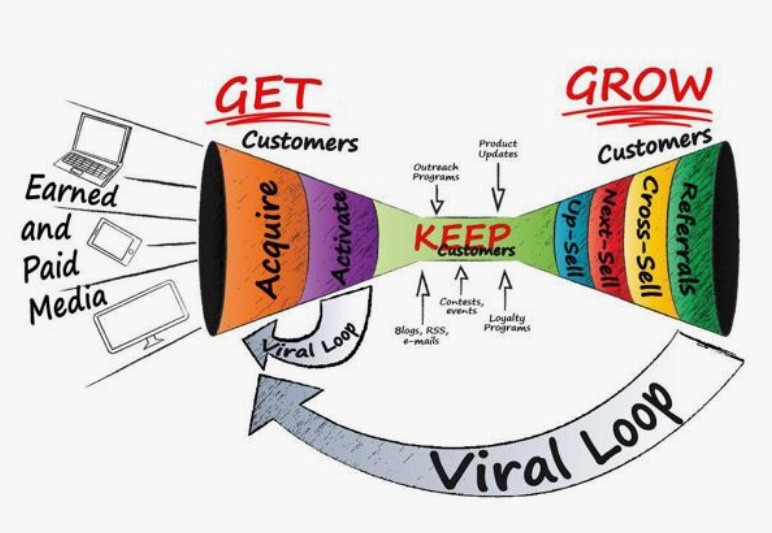
The following building block is about Customer relationships. Here you will enter the way you get, keep, and grow your customer base.
- How you get your customers refers to the ways audiences find out about you and decide to buy things from you. It may be via advertising on Google or posts on social media.
- How you keep your customers looks at the customer service that you offer or discount programs appreciate and help your customers who buy from you.
- How you grow your customers means the way you start to make your customers continue buying and spending money on your company. A very common way is sending a newsletter every month to customers so that they can be informed about the latest campaign and consider buying more.
In order to enter details in this building block, you should understand your customer journey clearly. Question yourself on how your customers find out about you, how they decide to buy your products, how they purchase them, and how they manage after purchasing.
Revenue streams
Revenue streams building block refers to the sources where the money comes from. Here you will need to enter where your revenue is generated. Perhaps, this building block is the most confusing on the right side.
It is because you will need to find out the strategy as well as the campaign you will start to generate the most value from your customer base.
It looks at multiple aspects. You might consider a monthly subscription fee or a one-time fee for your customers. You might also think about giving away products for free so that your customers will decide to upgrade to the paid premium product.
Take Advertising on Google as an example. In order to be displayed in front of users and customers, advertisers need to pay Google money and send it their buying intent together with ads information. As an audience, only when you search for something with purchasing intent will you see ads. On the other hand, you probably will not see anything related to advertising if you search for something without purchasing intent.
If you are starting a subscription-based business, you will have the benefit of recurring revenue streams pouring in regularly. However, it can be more of an uphill struggle to convert customers than if you are charging them a one-time fee, because more of a commitment is required on their part. It’s a case of determining which approach fits best with your goals and product category.
As you can see, we have gone through all building blocks on the right side which are related to customers. Now, it’s time to work on the building areas to the left of the Value proposition which shows the costs to the business.
Key resources
The first building block to concern when it comes to the left hand is Key Resources. That means the main strategic assets that are needed to enable your business model to work.
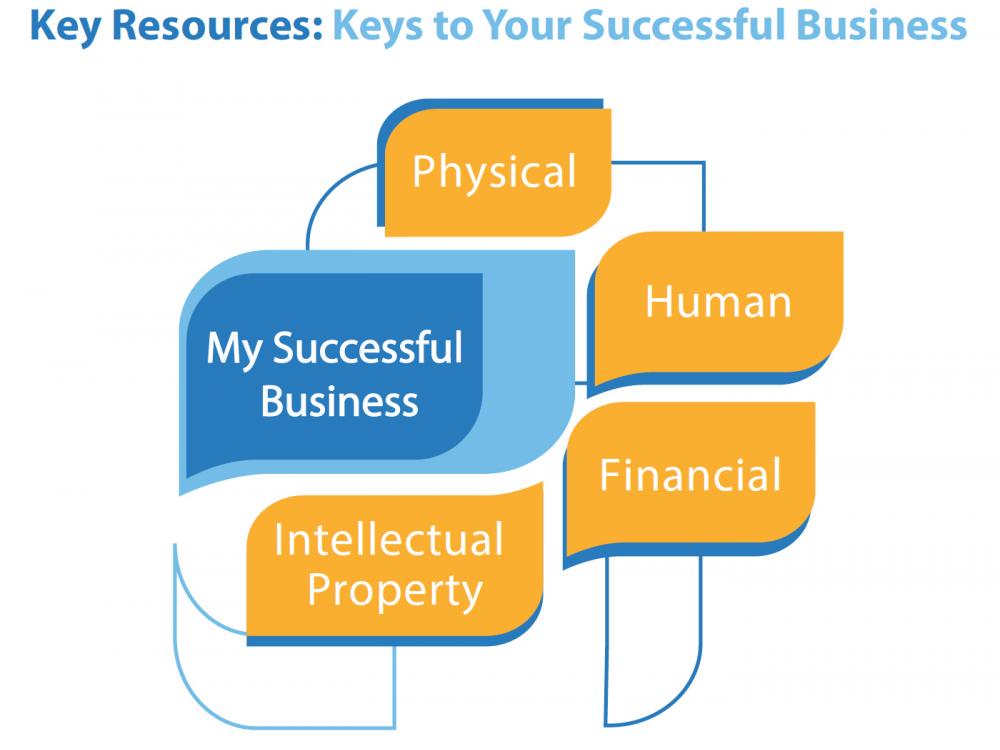
There are four categories of resources, they include:
- Physical resources: They can be cars, machines, buildings, or distribution networks.
- Human resources: They are your staff members who make your business work in real life. Human resources take an indispensable part in every business. When it comes to creative and knowledge-intensive industries, they seem to be the most important resource of a company.
- Intellectual resources: They are specialist knowledge, documentation, patents and copyrights, partnerships, customer information, or brands.
- Financial resources: They are lines of credit, cash balances, and so on.
Key activities
The next building block is Key activities which refer to the most important strategic things you Must do to make your business model work. Remember that the Key activities block should be completely relevant to the value proposition block.
Check to see whether your Key activities are relatable to your value proposition or not. If they aren’t, then something must be changed. There will be one or more activities you regard as the most important but generate no values or revenue.
There are three main types when it comes to key activities. They are:
- Production: The first one looks at the delivery process of your products. Businesses tend to do this with a high number and high quality at the same time.
- Problem solving: Do you work with consultancies and other service organizations to bring about the best solutions to solve the problems of each customer segment.
- Platform or Network: They can be networks or software platforms as long as they can work as a platform.
Many businesses go in the wrong direction while listing all the activities that are done by their businesses. Prevent yourself from that by only entering activities that are main to delivering your value proposition.
Key Partnerships
Key partners building block is quite similar to the previous one. You also list the activities which you view as important. However, they are not done on your own but by working with suppliers and partners to make the business model work.
Take Spotify as an example. The company let updating its platform be the key activity. Nonetheless, Spotify cannot produce the music it provides. Therefore, the company needs to list its deals with record labels and publishing houses in the Key partners building block.

If you are wondering why your business should create a partnership, it is because of economies of scale. What’s more, that can help prevent yourself from risk and uncertainty which leads to crisis. Finally, it brings about the acquisition of resources or activities.
Cost structures
The last building block is Cost Structure in which you map key activities to costs.
One thing to keep in mind is making sure all the costs you list are related to your value proposition.
Additionally, Cost structure should be the last building block you fill in. Therefore, after defining your Key Resources, Key Activities, and Key Partnerships, it is necessary to find out the most important costs as well as the most expensive ones.
Why might you want to create a business model canvas?
You might wonder why creating a business model canvas is crucial and how you will benefit from this canvas when starting your own business. There are various answers to your questions but here are the three most noteworthy:
Roadmapping rapidly
A canvas can be handled in a short time, even with the sticky-notes. You do not need to make every effort to put down everything about your product plan, you can simply list out the features, the necessary content.
However, it will be useless if you just stop at these highlights. The next step is to convert the canvas into your roadmap with your product’s details.
Time saving
Before the business model canvas appeared, people who wanted to get their product to market were familiar with the old structure of citing a business model. On the other hand, the issue with this traditional method was that it was hardly accurate by the time the writer completed the draft.
It is also accessible to explain this situation as this model consisted of important elements such as detailed cost estimates, revenue projections going years into the future, and permanent plans for growing the staff, which are all changeable in just a short period of time.
When it comes to products, these plans are considered MRD (Market Requirements Document). This particular paper is lengthy, intricate, and can barely be true as soon as it’s finished.
Luckily, a canvas is here to help you overcome these obstacles. You can quickly combine a canvas that is capable of showing your strategy and your brand’s current status. And in case there are changes, you will need less effort and time to edit.
Easy to swivel
It is so evident that the market is at no time stable. There are always new things adopted and some old ones have to be eliminated, which require you to be ready for any changes, to swivel due to reality.
Therefore, a canvas should be your priority. It is so sharp and top-level that you can easily adjust if needed rather than MRD or traditional business plans. With the length of just one page, a business model canvas plays a vital role in your brand guiding strategy.
Moreover, you can instantaneously and rapidly update your approach or any features due to your market observation.
10 examples of business model canvas in different industries
Example #1: A Lemonade Stand
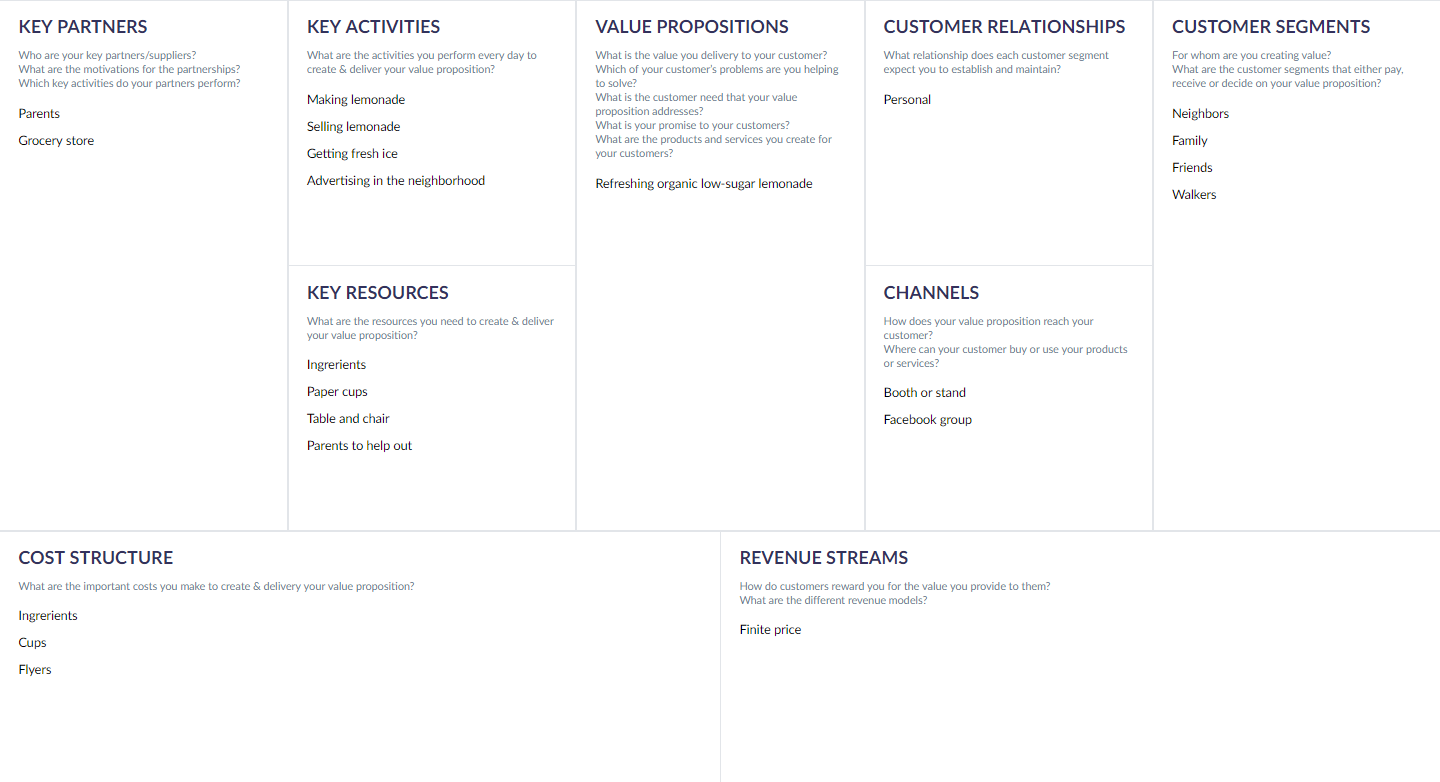
A lemonade stand can be a great example of your initial approach to a business model canvas. It is likely the most understandable model for one’s first experience with starting a business.
In this model canvas, you can clarify your customer segments, possibly your neighbors, walkers, family, and friends. However, they are not limited to your customers; they can be your partners, suppliers, resources as well.
Therefore, you need to write down the proper ways of reaching customers in the Channels building block. And Facebook groups, booths, or stands are considered the most suitable choice for a lemonade stand. Turning to revenue streams, it is quite simple with a lemonade stand because they mostly come from a finite price for a drink.
Example #2: Skype
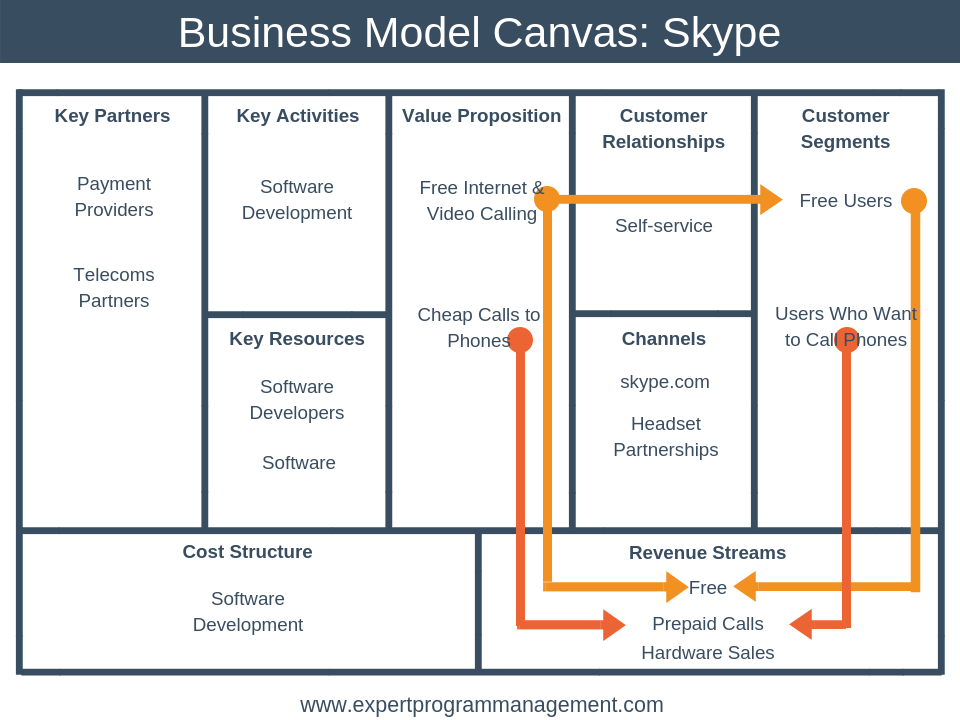
As can be seen, Skype provides users with 2 value propositions: free Internet & Video calling and cheap calls to phones. These propositions correspondingly help Skype attract 2 customer segments: free users and users who want to call phones.
In Skype’s model business, there is a majority of users who make free calls via the Internet, and just 10% of users choosing the prepaid service. We can explain this business model by looking at key partnerships, key activities, and key resource building blocks.
Key partnerships, key activities, and key resources are the three elements that allow Skype to offer low-priced and free calls. Unlike other traditional telecoms providers, Skype does not have to build and manage a huge and complicated infrastructure to work effectively, Skype just relies on backend software and the servers hosting user accounts, which is called the freemium business model.
Example #3: Gillette
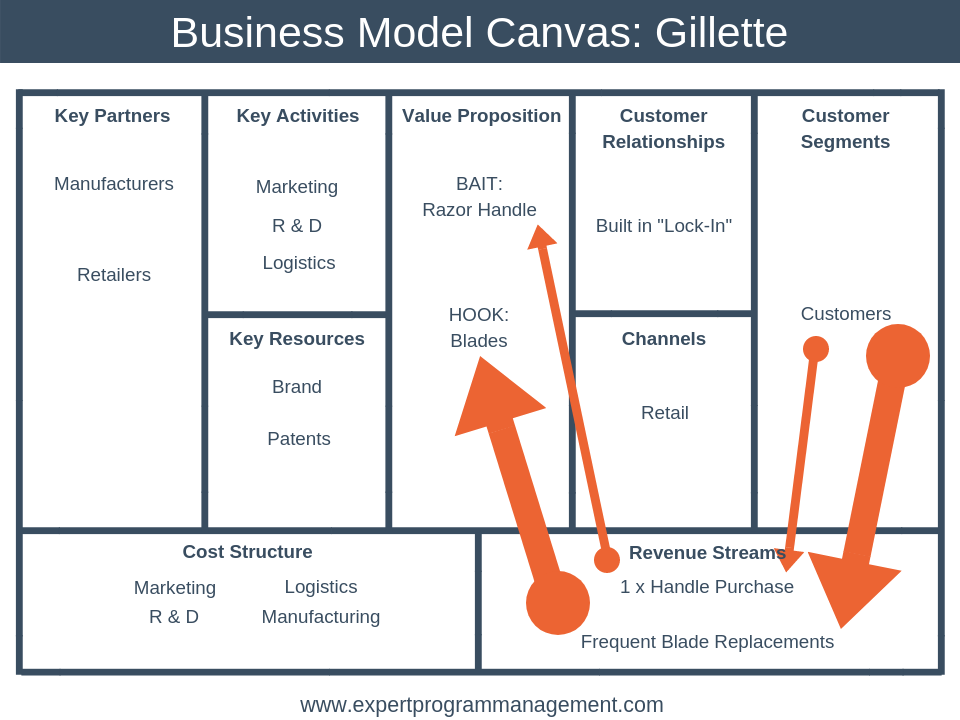
In Gillette’s case, their business model follows the business model pattern called “Bait & Hook”, the pattern that is followed by many SaaS (Software as a Service) companies.
Gillette gives their customers a cheap or even free of charge original offer, a razor handle. This offer is the bait that enables customers to experience and get acquainted with Gillette’s products and makes them more likely to buy related products, the blades.
In the above diagram, the size of the arrow is in direct proportion with the revenues generated. All Gillette’s revenues are from just one customer segment, which mainly depends on Frequent Blade Replacements.
Pay attention to the left corner of Gellettes Business Model Canvas, it will demonstrate the consistent relation between all major costs and the value proposition. For instance, Gillette strengthens its brand by spending money on marketing and assures the brand’s uniqueness in the blade and handles technology with R&D costs.
Example #4: Google
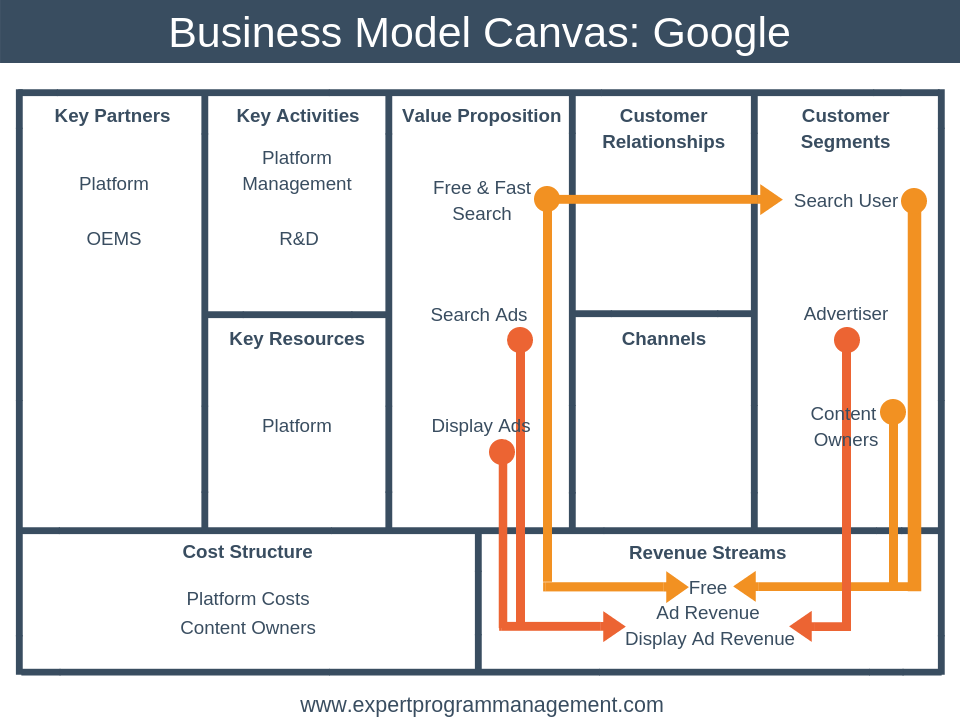
When it comes to business model canvas, we will not want to miss the outstanding example of Google.
Google’s business model is many-sided, which means their customer segments are not exclusive. Google has separate groups of customers, but these groups are related to each other.
In Google’s model, it is a platform whose customers are search users and advertisers. If there are no search users, there will not be advertisers and vice versa, search users will not be able to freely take advantage of this platform without advertisers.
As we can see, Google displays ads in search results or on web pages which costs advertisers an amount of money. With this money, content creators are paid and search users can browse free of charge.
Google’s kind of business model creates a network, which means the ads it displays to web users are directly proportional to advertisers and so as the content owners.
In terms of key resources, Google.com, Adsense (for content owners), and Adwords (for advertisers) build up Google’s search platform. Hence, managing the existing platform and its framework must be Google’s key strategic activities.
It is clear that one of their key partners is content owners, without whom there would not be search users or advertisers. Another partner of Google is OEMs (Original Equipment Manufacturers).
OEMs (Original Equipment Manufacturers) provide Google with mobile handsets that allow this huge platform to operate its system at no charge. And to give back, when users of these handsets surf the Internet for information or entertainment or whatever, they choose Google’s platform by default. This process will consequently lead more web users to the ecosystem, meaning that more revenue will be raised.
Example #5: Airbnb
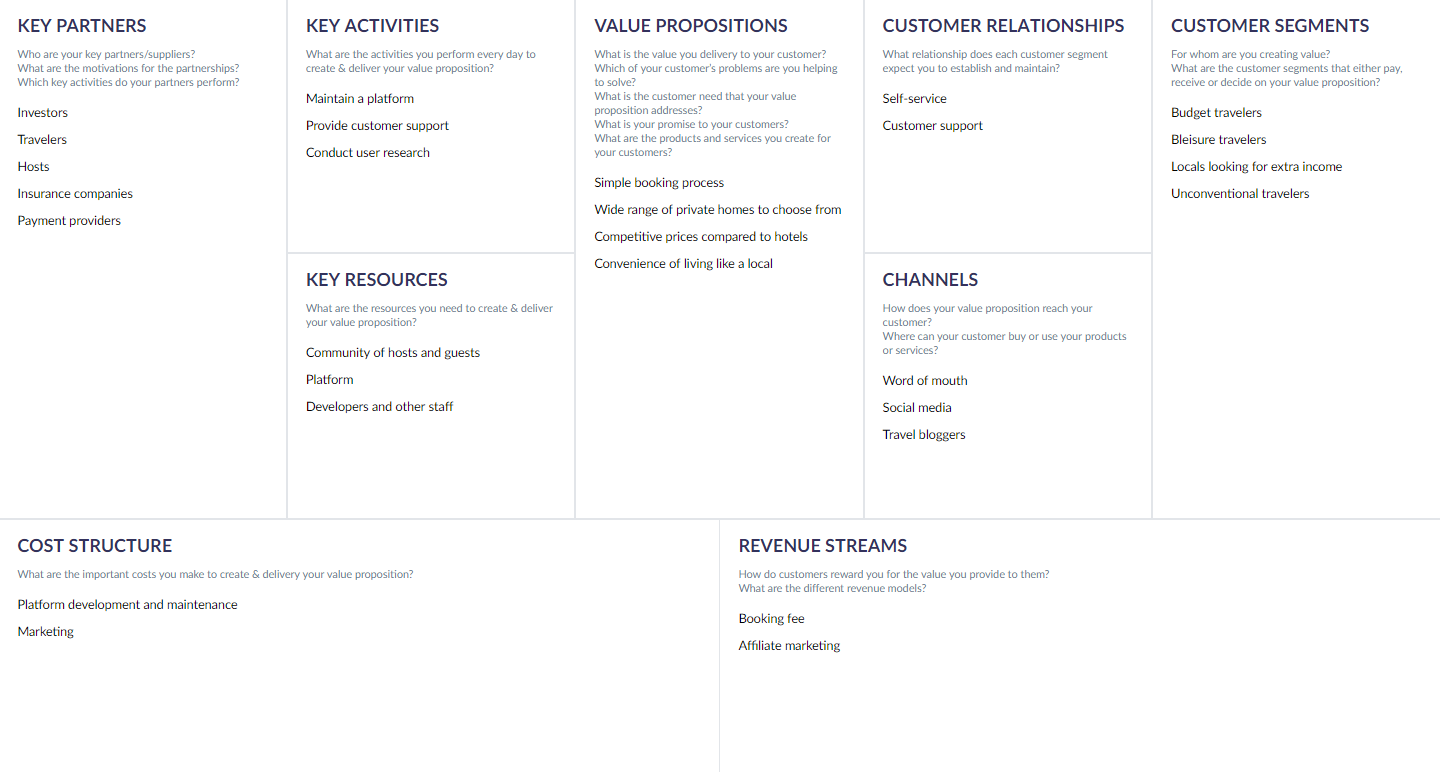
Another example is Airbnb, a widely-known online marketplace that lets people rent out their properties or spare rooms to guests and then Airbnb takes 3% commission of every booking from hosts, and between 6% and 12% from guests. And now, it is time to figure out its business model canvas.
It is clear that Airbnb has 2 separate customer segments: guests and hosts, but they can be divided into other small categories with particular characteristics. Airbnb’s value propositions also follow the same pattern: they give their customers more affordable choices than traditional hotels and provide customers with deluxe or fancy services.
About Airbnb’s revenue, as mentioned above, their main revenue is from the fees that they charge both guests and hosts.
Example #6: Uber
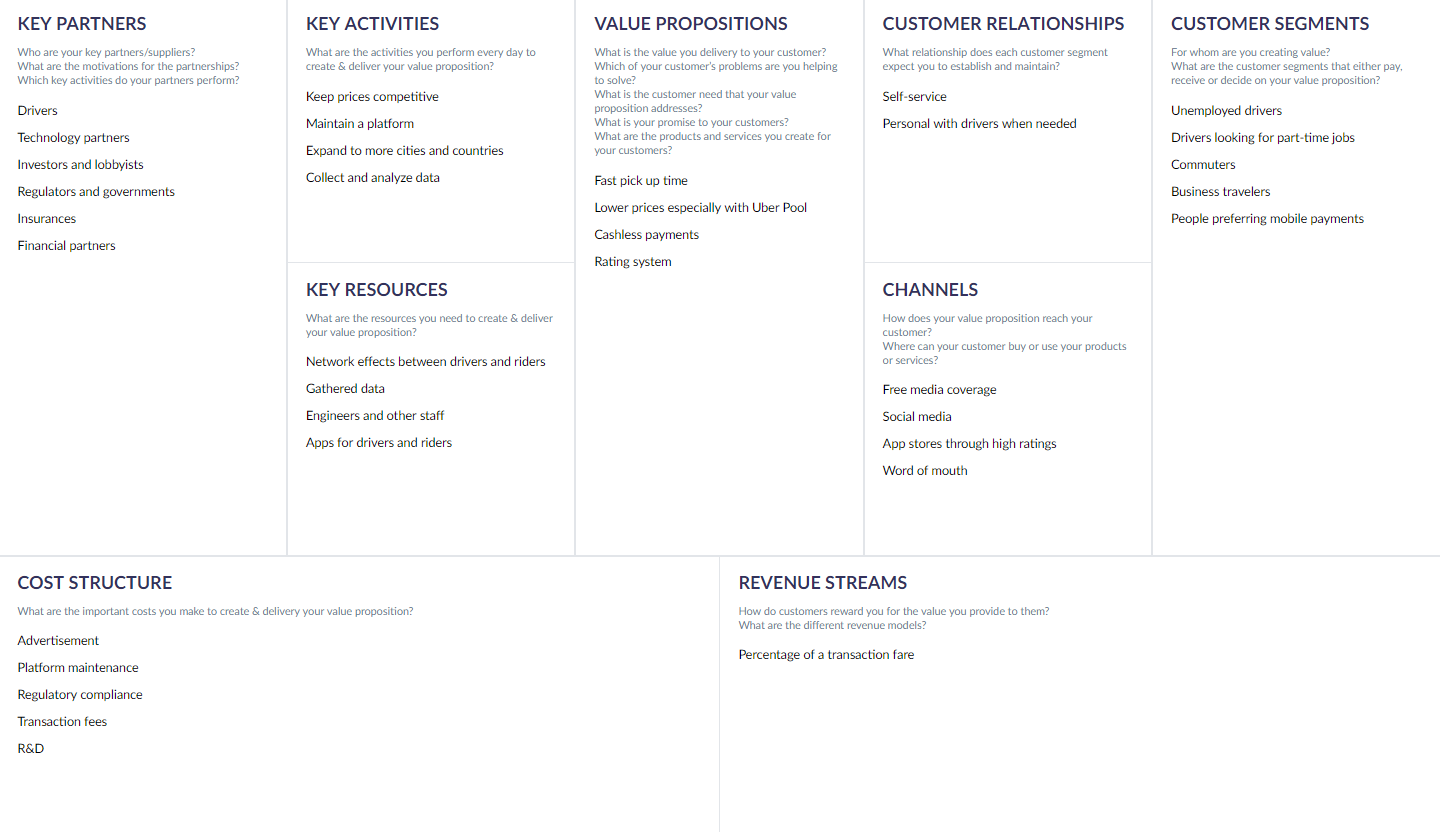
Our next business model canvas is Uber, the world’s largest taxi company, which owns no vehicles. Uber is an excellent illustration of a business model canvas as it is an outstanding business with such representative innovation in technology.
As can be seen, Uber’s customer segments include 2 big categories: drivers and riders. In drivers, Uber targets 2 particular groups: unemployed drivers and drivers looking for part-time jobs, which consequently lead to their corresponding methods of approaching customers. It means, for example, to attract unemployed drivers who are likely to live in areas with high unemployment rates, Uber has to use Word of mouth as a channel.
Example #7: LinkedIn
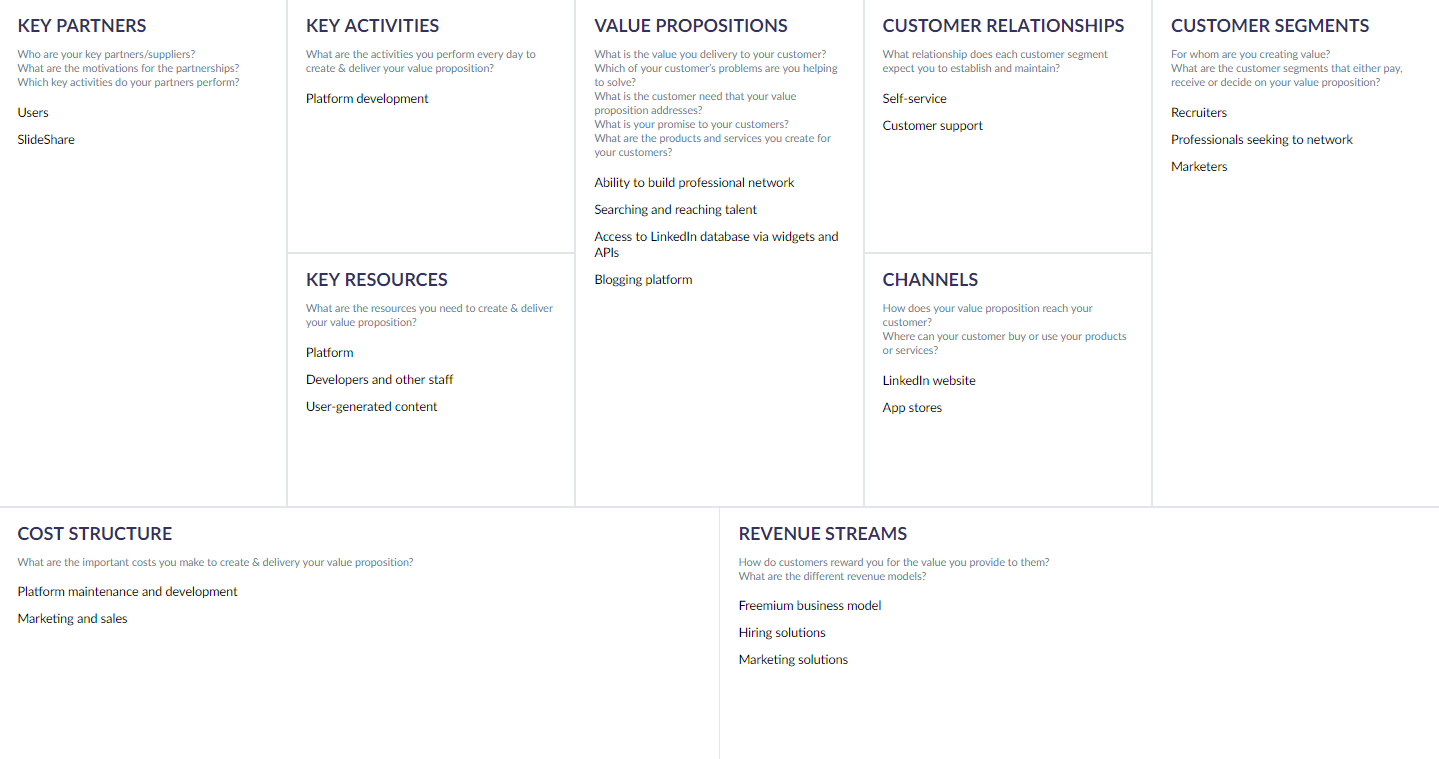
LinkedIn is the online platform that enables you to find the right job or internship, connect and strengthen professional relationships, and also learn the skills you need to succeed in your career. It means LinkedIn provides users with diverse services as shown in the Value propositions building block.
Therefore, in their business model canvas, LinkedIn pointed out 3 big customer segments: recruiters, professionals seeking to network, and marketers.
Turning to LinkedIn’s revenue streams, LinkedIn’s revenues mostly come down to these 3 sources: freemium business model, hiring solutions, and marketing solutions. And as a result, they have to consider developing the platform as the most important activity.
Example #8: Amazon
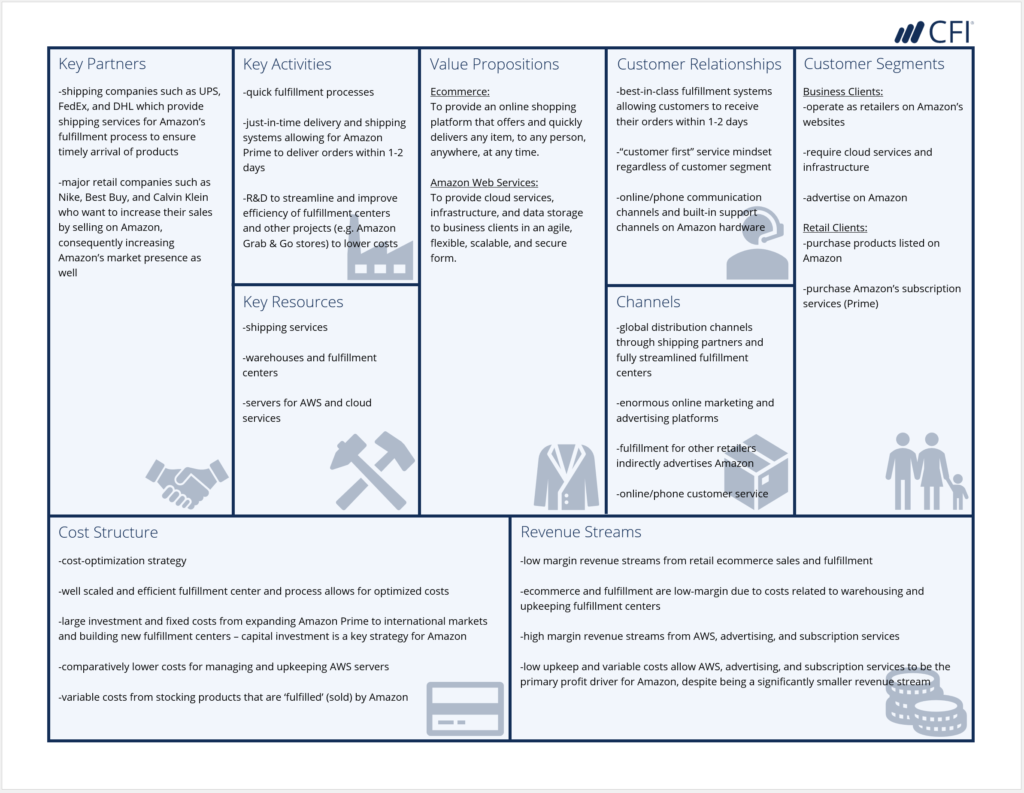
Amazon’s business model canvas is an example that we should not miss in the e-commerce field. Amazon’s model’s most remarkable element is its key activities, which help Amazon stand out among many competitors.
As we know, time and money are important to every buyer and so is Amazon.
Hence, Amazon’s key activities are quick fulfillment processes, in-time delivery, and shipping systems allowing for Amazon Prime to deliver orders within 1-2 days, and Offshore R&D Center to streamline and improve the efficiency of fulfillment centers and other projects (e.g. Amazon Grab & Go stores) to lower costs.
About Amazon’s customers, there are two main groups that use Amazon’s products and services: business clients and retail clients, which means they have to develop strong and complicated ways of serving their customers.
Example #9: Netflix
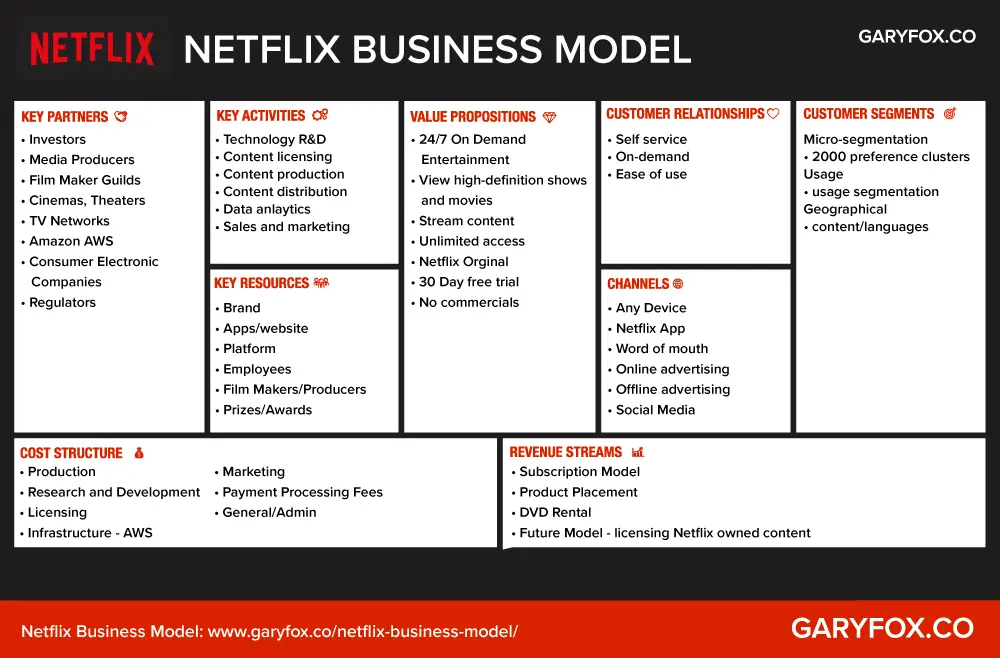
Many companies compete against Netflix, such as Amazon Prime Video, Apple TV+, Disney+, HBO, Hulu, Vevo, and Youtube. However, Netflix is still doing well and developing its business worldwide with such a unique and effective business model canvas.
Netflix uses 6 key resources: brand, apps, platform, employees, filmmakers, and prizes, to attract its customers. Recently, Netflix’s content production activity shows its strengths as Netflix series are welcomed by large audiences and are gradually dominating the film market.
Example #10: Tesla
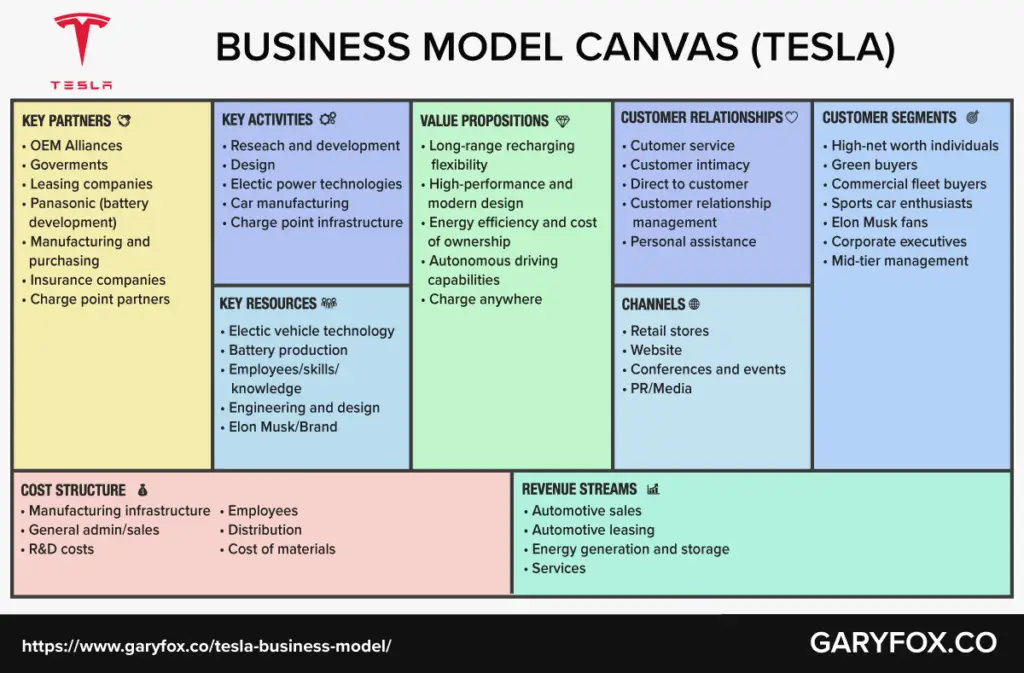
Tesla is a business model that chooses technology as a benefit. As shown in the business model canvas, one of Tesla’s customer segments is the green buyer which directly leads to the corresponding key activities. They have to concentrate on research and development, design, electric power technologies, car manufacturing, and also charge point infrastructure to provide customers with synchronous solutions and services.
Conclusion
If you are about to start a business, make sure that you will not forget about the business model canvas. The business model canvas, which consists of 9 elements will help you determine what is crucial for your business regardless of whether your business is big or small.
New Posts






